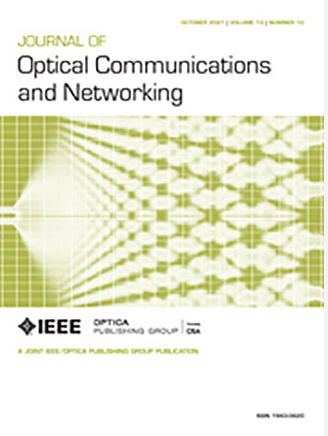Real-time capable, low-latency upstream scheduling in multi-tenant, SLA compliant TWDM PON
IF 4.3
2区 计算机科学
Q1 COMPUTER SCIENCE, HARDWARE & ARCHITECTURE
引用次数: 0
Abstract
Virtualized passive optical networks (vPONs) offer a promising solution for modern access networks, bringing enhanced flexibility, reduced capital expenditures, and support for multi-tenancy. By decoupling network functions from the physical infrastructure, vPONs enable service providers to efficiently share network resources among multiple tenants. In this paper we propose a novel, to our knowledge, merging DBA algorithm called the dynamic time and wavelength allocation algorithm for a virtualized DBA architecture in multi-tenant PON environments. The algorithm, which enables the merging of multiple virtual DBAs into a physical bandwidth map, introduces multi-channel support, allowing each optical network unit (ONU) to dynamically change, taking into consideration different switching times and transmission wavelengths. Leveraging the Numba APIs for high-performance optimization, the algorithm achieves real-time performance with minimal additional latency, meeting the stringent requirements of SLA-compliant, latency-critical 6G applications and services. Our analysis highlights an important trade-off in terms of throughput under multi-tenant conditions, between single-channel versus multi-channel PONs, as a function of ONU tuning time. We also compare the performance of our algorithm for different traffic distributions. Finally, in order to assess the time computing penalty of dynamic wavelength optimization in the merging DBA algorithm, we compare it against a baseline static wavelength allocation algorithm, where ONUs are designated a fixed wavelength for transmission.实时、低延迟的多租户上行调度,符合SLA的TWDM PON
虚拟化无源光网络(vpon)为现代接入网提供了一种很有前途的解决方案,它带来了增强的灵活性、减少的资本支出和对多租户的支持。vpon通过将网络功能与物理基础设施分离,使服务提供商能够在多个租户之间高效地共享网络资源。在本文中,我们提出了一种新颖的,据我们所知,称为动态时间和波长分配算法的合并DBA算法,用于多租户PON环境中的虚拟化DBA体系结构。该算法可以将多个虚拟dba合并到一个物理带宽映射中,引入了多通道支持,允许每个光网络单元(ONU)根据不同的交换时间和传输波长动态变化。利用Numba api进行高性能优化,该算法以最小的额外延迟实现实时性能,满足符合sla的延迟关键型6G应用程序和服务的严格要求。我们的分析强调了在多租户条件下,单通道和多通道pon之间的吞吐量方面的一个重要权衡,作为ONU调优时间的函数。我们还比较了算法在不同流量分布下的性能。最后,为了评估合并DBA算法中动态波长优化的计算时间损失,我们将其与基线静态波长分配算法进行了比较,其中onu被指定一个固定的波长用于传输。
本文章由计算机程序翻译,如有差异,请以英文原文为准。
求助全文
约1分钟内获得全文
求助全文
来源期刊
CiteScore
9.40
自引率
16.00%
发文量
104
审稿时长
4 months
期刊介绍:
The scope of the Journal includes advances in the state-of-the-art of optical networking science, technology, and engineering. Both theoretical contributions (including new techniques, concepts, analyses, and economic studies) and practical contributions (including optical networking experiments, prototypes, and new applications) are encouraged. Subareas of interest include the architecture and design of optical networks, optical network survivability and security, software-defined optical networking, elastic optical networks, data and control plane advances, network management related innovation, and optical access networks. Enabling technologies and their applications are suitable topics only if the results are shown to directly impact optical networking beyond simple point-to-point networks.

 求助内容:
求助内容: 应助结果提醒方式:
应助结果提醒方式:


